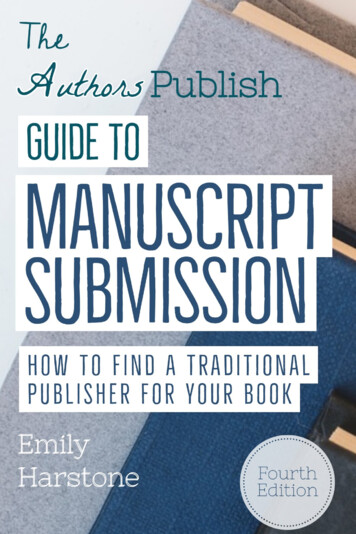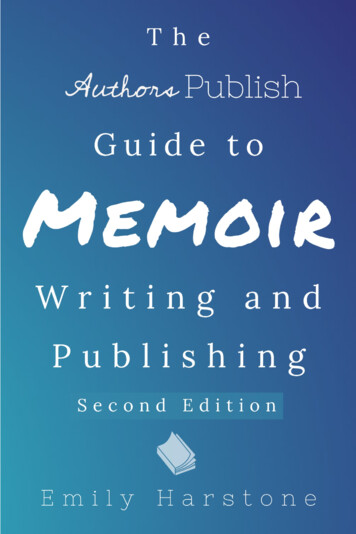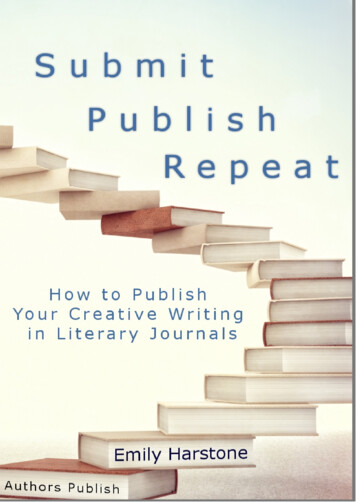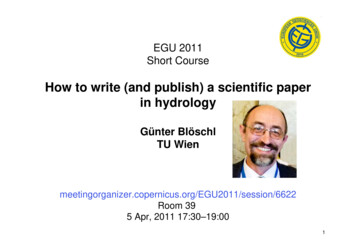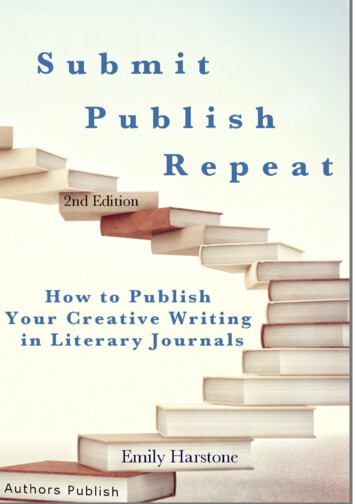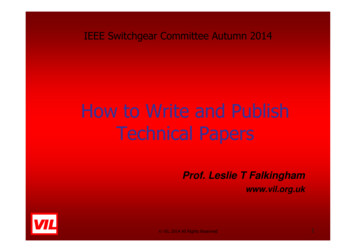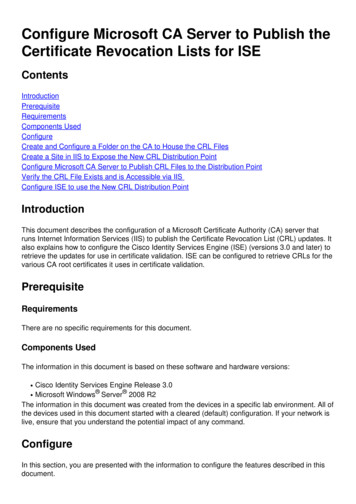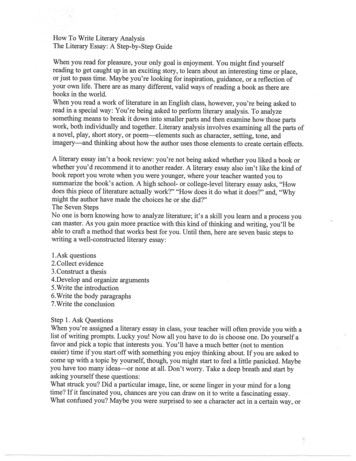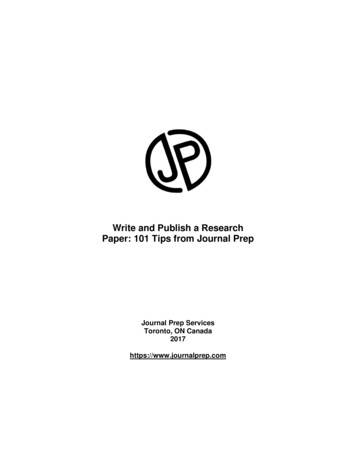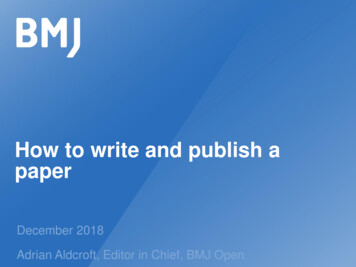
Transcription
How to write and publish apaperDecember 2018Adrian Aldcroft, Editor in Chief, BMJ Open
Writing research papers and using reportingguidelines Resources IMRaD Writing style
Research to Publicationrtop.bmj.com
Core guidance on writing papers International Committee of Medical Journal Editors recommendations formanuscripts submitted to biomedical tml Reporting guidelines for research, at the EQUATOR networkhttp://www.equator-network.org/
ICMJE guidelines on manuscript preparationThe International Committee of Medical JournalEditors (ICMJE) is a small working group of generalmedical journal editors that meets annually to work onthe Recommendations for the Conduct, Reporting,Editing and Publication of Scholarly Work in MedicalJournals.Members: Annals of Internal Medicine, The BMJ,Canadian Medical Association Journal, ChineseMedical Journal, Ethiopian Journal of Health Sciences,JAMA, Nederlands Tijdschrift voor Geneeskunde (TheDutch Medical Journal), New England Journal ofMedicine, New Zealand Medical Journal, RevistaMédica de Chile, PLOS, Tidsskrift for Den NorskeLægeforening (The Journal of the Norwegian MedicalAssociation), The Lancet, Ugeskrift for Laeger(Journal of the Danish Medical Association), the U.S.National Library of Medicine, and the WorldAssociation of Medical Editors.
EQUATOR network Enhancing the QUAlity and Transparency Of health Research
EQUATOR Network and Penelope Tool to help choose a report and complete a checklist http://www.goodreports.org/ Tool integrated with BMJ Open to help authors submit theirpaper https://app.penelope.ai/manuscript-check/bmj open
Guideline checklist example: STROBE
IMRaD structure for research papers Introduction: why ask this researchquestion? Methods: what did I do? Results: what did I find? and Discussion: what might it mean?Austin Bradford Hill, BMJ 1965
IMRaD structure: Introduction Brief background for this audience3-4 paragraphs only: mind the word limitWhat’s known/not known on research questionDon’t bore readers, editors, reviewersDon’t boast about how much you have readThe research question State it clearly in last paragraph of introduction State why the question matters
IMRaD structure: Methods I Should be like a recipeMost important section for informed readersFollow reporting guidelines, e.g., CONSORT StatementDescribe measures to ensure ethical conductFully describe and give references for lab/stats methodsQuestion: How detailed do you think the methods should be?
IMRaD structure: Methods II Describe PECO/PICO elements of the study: P - which patients, which population, what problem(s)? I or E - which intervention(s) or exposure(s)? C – which comparison group? Any randomisation or stratification? O - what outcome(s) or endpoint(s)? Define primary and secondary outcome(s)
Ethical aspects to consider in the MethodssectionEthics aspects of methods: What was the consent procedure? Were there any deviations from normal practice? Might publication reveal patients’ identities? What burden was imposed? What are the risks and benefits for participants/others? How might society or future patients benefit in time?
IMRaD structure: Results Report results fully & honestly, as pre-specifiedText (story), Tables (evidence), Figures (highlights)Report primary outcomes firstGive confidence intervals for main resultsReport essential summary statisticsLeave out non-essential tables and figures; these can beincluded as supplementary files Don’t start discussion here
IMRaD structure: Discussion Don’t simply repeat the introduction. Include the following: Statement of principal findings Strengths & weaknesses of the study Strengths & weaknesses in relation to other studies & key differences Possible mechanisms & explanations for findings Potential implications for clinicians or policymakers Unanswered questions and future research
Abstracts Often the only part of the study thatwill be read All authors must approve it Editors may screen papers based onthe abstracts Structured abstracts for The BMJneed: 300-400 words Structured format Active voice Results plus p values %s with denominators No references Trial registration details
Structured abstracts
Question: With the technology available today,should we still be using the IMRaD structure? There are new opportunities (e.g.,video abstracts and methods,publishing datasets) There have been changes toresearch article format (data andPPI statements) However there is a logic andsimplicity that makes the IMRaDstructure relevant today
Why publish study protocols?Why publish study protocols? Keep researchers and funding bodies up-to-date Enable collaboration amongst the researchcommunity Prevent unnecessary duplication of work Increase transparency by making moreinformation available than required by trialregistries Give others the opportunity to see andunderstand deviations that occur during thestudy Increase transparency and trust
Publishing study protocols in BMJ Open Protocol manuscripts should report planned orongoing research studies. We will not consider studyprotocols for research that is complete or nearingcompletion. If available, use reporting guidelines specific to studyprotocols (e.g., SPIRIT and PRISMA-P)
Publishing study protocols in BMJ Open Broadly use the same principles and policies as research articles,with the following differences: Please include the planned dates of the study both in themanuscript and cover letter Include an Ethics and Dissemination section in both the Abstractand manuscript A Discussion section is not required
Peer review of study protocols in BMJ Open BMJ Open will consider publishing without peer review protocols thathave formal ethical approval and funding from a recognised, open accessadvocating research-funding body (such as those listed bythe JULIET project) Provide proof of peer review by the funder as part of the manuscriptsubmission The intention of peer review is not to alter the study design, but to judgewhether the study design is sound and to improve reporting/transparency
Choosing a journal Factors in choosing a journal Journal metrics (e.g., Impact Factor) Predatory journals
What journals provide: peer review &scholarly publishing
Factors to consider when choosing a journal Journal scopeJournal indexing and Impact FactorLanguage of publicationLikelihood of acceptanceSpeed of publicationColleagues’ adviceOpen access or not?Publication feesEditorial and peer review policies
The purpose of journals often differs For readers Many journals focus largely on readers, choosing and commissioning articlesof most interest and use to particular types or group of readers (eg The BMJ,BMJ Supportive and Palliative Care). These may appear online as well as inprint, and may provide Open Access. For authors and funders Some newer “megajournals” focus on providing authors with a fast, fair peerreview process; relatively high acceptance rates, rapid online onlypublication; and Open Access, e.g., BMJ Open, PeerJ, F1000 Research.
Impact Factor: Questions Do you use the Impact Factor whenselecting a journal (either as an author or areader)? Do you think journals with a high ImpactFactor are “better”? Do you know what the Impact Factorrepresents?
Impact FactorThe 2017 IF for a journal is calculated using the following ratio:Total citations to scholarly articles (published in 2015 and2016) in 2017Number of citable articles in the journal in 2015 and 2016
Impact Factors An Impact Factor of 1.0 means that, on average, the articles published 1-2 yearsago have been cited one time. An Impact Factor of 2.5 means that, on average, the articles published 1-2 yearsago have been cited 2.5 times. The citing works may be articles published in the same journal. .however, mostare from different journals, proceedings, or books indexed by Web of elp/h impfact.htm
Impact Factor: Positives Intuitively, it seems like a sensible metric touse to place a value on a journal Choosing a journal can be difficult—aquantifiable measure is extremely useful.Impact Factor has become the standard inthe publishing industry.
Impact Factor: Problems Different journals have different objectives Authors and publishers play the ImpactFactor “game” Chasing Impact Factor contributes to biasin the scientific record The Impact Factor can be seen as adriver for research misconduct
Limitations of Journal Impact Factor Skewed by a minority of highly cited articles, e.g., review articlesCannot be compared across fieldsHigher in research fields with literature that is cited quicklyMay be artificially inflated by “self citation” by journalsCalculated using the SCI database that includes only some journals, with a biastowards journals in English
Alternatives: Citation distribution
Article Level Metrics Article-Level Metrics (ALMs) are a new approach to quantifying the reach andimpact of published research. As electronic dissemination of scholarly content has surpassed print, it hasbecome easier to disaggregate an individual article’s impact from the publicationin which it appeared. It’s also possible to track different markers of an article’s reach, beyond justcitations. ALMs seek to incorporate new data sources (sometimes referred to as“altmetrics”) along with traditional measures to present a richer picture of how anindividual article is being discussed, shared, and etrics/
ut-and-score/
Predatory journals These are publications taking fees withoutproviding robust editorial or publishingservices. They recruit articles through aggressivemarketing and spam emails, promising quickreview and open access publication for aprice. There is little if any quality control andvirtually no transparency about processesand fees. Their motive is financial gain, and they arecorrupting the communication of science.
Get an ORCID number
Common issues with Chinese submissions Not using a reporting guideline or tailoring themanuscript to the Instructions for Authors Solution: Use the EQUATOR guidelines andPenelope tool Unclear timeframe/study design Solution: More detailed methods sections(including timeframes). Publishing/providingstudy protocols Not including limitations Solution: Be honest Publication ethics (e.g., plagiarism,authorship changes) Solution: Be up front and honest—editorscan be harsh when this issues areuncovered at a late stage
Thank you
How to write and publish a paper December 2018 Adrian Aldcroft, Editor in Chief, BMJ Open. Writing research papers and using reporting guidelines Resources IMRaD . Don’t simply repeat the introduction.
